The biggest challenge for global businesses in 2025 is the economic uncertainty, combined with the evolving workforce demographics, and integrating AI into work ecosystems. To deal with such challenges, business leaders are identifying strategies that are aimed towards hiring new talent, building future leaders, and keeping employees engaged. Today, Enterprise Learning Management Systems (LMS) have become one such critical tool with robust features that optimize and enhance learning both inside the organization and beyond. A well-designed training infrastructure increases the efficiency of the training exercises, which translates to improved performance and productivity.
Nowadays, Enterprise LMS can not only amplify an organization’s growth but also assist companies in distinguishing themselves from their competitors. The increased demand for LMS systems is one of the crucial factors that has propelled the global e-learning industry, which is estimated to grow by $51.9 billion by the year 2028, with a CAGR of 18.6%, reported by Markets and Markets research. But what makes such a critical investment in LMS a necessity for many organizations today? Let’s explore!
What Is an Enterprise Learning Management System (LMS)?
An Enterprise Learning Management System (also called an “Enterprise LMS” or “ELM systems”) is a type of software that facilitates the administration and delivery of different training programs, documentation, tracking, and reporting for the organization’s employees. Usually, an Enterprise LMS is used to develop proficient knowledge and specific skills, obtain skill certification, and adhere to state and government laws.
Enterprise LMS supports a company’s learning and development strategy to increase business outcomes and enhance productivity. This is done by bridging skill gaps, improving engagement and retention, and extending corporate training programs to other stakeholders like partners, staff members, and customers. In fact, meeting corporate training needs through these platforms presents countless benefits to organizations.
The primary purpose of an enterprise LMS includes the following functions:
- Tracking
- Reporting
- Documentation
- Administration
- Automation
- Employee remote learning
- Delivering different training programs and educational courses
As a result, ELM systems assist businesses in fully utilizing the benefits of modern training programs. The mixed learning approach (formal, informal, and combined learning) is a universal solution for most business owners and employees.
Top 5 Benefits of Enterprise Learning Management System (LMS)
The trend of LMS platforms development evolves from traditional ways of training staff members and goes far deeper than that. An enterprise learning plan needs to be carefully drafted, not as an educational program to inform employees, but as a framework that has the potential to change your organization for the better. This helps to drive your business towards success, agility, and sustained growth over time. Ultimately, choosing the right LMS will not only improve training but also positively impact business outcomes. Here are the top 5 benefits of enterprise LMS:
1. Quicker Value Recognition
Structured learning and role-specific learning will enhance the speed at which your customers understand and utilize your product and services. This will eventually help them recognize value-adding benefits at an early stage, resulting in faster time to value.
2. Increased Revenue Opportunities
Paid subscriptions, certifications, and premium courses are just some of the ways LMS can generate revenue.
3. Improved Retention Rates
Well-trained and educated customers will likely renew your service. When people understand best practices and advanced features, they can be turned into loyal users.
4. Improved Decision Making
An enterprise LMS enables tracking metrics associated with the courses offered to evaluate their impacts on other business functions and overall performance. Whether it’s measuring progress through course completion or linking training to increased retention, you have insights to improve everything.
5. Improved Efficiency
An LMS saves your team hours of manual work by providing automation tools for course enrollments, certification renewals, progress tracking, and other tasks.
Tips To Choose The Best Enterprise Learning Management System (LMS) In 2025
Choosing the best enterprise LMS could be a challenging task. So it is crucial to grasp which LMS solution aligns with your company’s requirements by evaluating all the necessary features. We will walk you through some tips to make informed decisions and find a productive and suitable LMS in 2025:
1. Intuitive UI Design
Both custom and ready-made LMS solutions come with an ergonomic user experience, which is one of the key functionalities since it influences employee performance and engagement levels. That is why it is critical to provide a basic, intuitive environment within which training can be administered seamlessly to other departments within the organization or its global network without any hassle.
2. Advanced Reporting & Analytics
With this feature, organizations can closely monitor and assess the effectiveness of the training performance. Nowadays, many extended enterprise LMS systems provide metrics that clearly evaluate every aspect of your online training. These include metrics from assessment results, to the most popular and impactful courses, those that drive higher sales, and more.
Beyond built‑in dashboards, L&D teams often need a quick way to turn raw assessment scores into final grades and model pass thresholds. For ad‑hoc checks or sharing grade breakdowns with managers, try a free test grade calculator to find your final test grades easily with Canva tools; input correct/total items, apply weighting, and instantly visualize results. This helps reviewers validate LMS reports, align cut scores, and communicate outcomes in seconds.
3. Certification Features
Enterprise LMS solutions offer credentialed training and issue supporting certifications. These can allow learners to demonstrate their capabilities by proving mastery of the relevant skills. Certification features support enhanced motivation, enable monitoring and evaluation of performance, assess knowledge level, and focus training on pre-defined goals for participants.
4. Customization & Personalization
Customization and personalization are equally essential features for both companies and employees. On the one hand, they can change the design and branding interface, revise the courses and materials. On the other hand, learners can unlock more opportunities that cater to their educational needs.
5. Cross-Platform & Device Friendly
Just as with the UI, businesses should also pay attention to the ease of access for trainees with respect to their learning management systems. Usually, this means developing a solution that can be accessed on various platforms and devices. This function enables users to access their training at any time and from any location, which significantly enhances productivity.
6. Secure & Compliant
Businesses need to pay greater attention to security than ever before. Organizations should choose systems that offer multi-factor authentication, data backup, and the ability to restrict unauthorized access. Furthermore, the LMS needs to align with the relevant legislation regarding data security (HIPAA, GDPR, SOX, etc.).
It is clear that having the right enterprise LMS that meets all business requirements is a daunting task and requires careful consideration of what the software market offers.
Develop Enterprise Learning Management System: Step-by-Step Guide
Developing an LMS solution for your organization may sound overwhelming at first, but having a step-by-step plan can make the entire process seamless. Here, we provide you with the process to develop an enterprise LMS for your business:
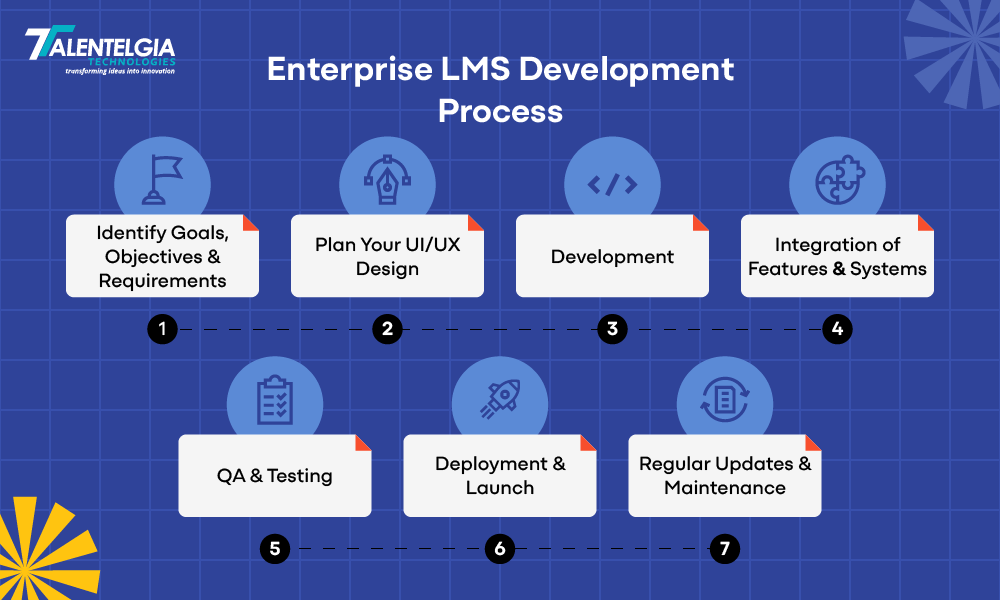
1. Identify Goals, Objectives, and Requirements
Clarifying the goals and objectives of any LMS platform is crucial to setting project milestones before its development process. Understand what problems it will solve and who it will serve—students, employees, or customers.
Also, define the requirements for the features, type of content, success metrics, and other objectives needed for it to be successful. Engaging IT, Human Resources, Trainers, and end-users as a part of initial project planning will facilitate gathering relevant support.
2. Plan Your UI/UX Design
After ideation and requirement gathering, proceed with the planning and design of the project. This includes focusing on—wireframes & prototypes, visual design & usability, and user flows & navigation. It is essential to plan your user interface and user experience design at this point. Designing clean and accessible wireframes or prototypes on how the LMS will look and making navigation easy should be your top priority.
However, the designs should be easy and user-friendly for all users. A flawless design will simplify development, enhance overall experience, and improve user satisfaction. These designs must adapt and support different devices. For better learning outcomes, consider adding multimedia elements such as quizzes, engaging videos, and interactive simulations.
3. Development
The development phase begins once the plan and design are finalized. Choose the right technology stack, which usually consists of front-end development (which deals with the user interface) and back-end development (which consists of building the logic, database, server-side APIs, etc.).
You can use frameworks like React, Angular, or Vue.js for a dynamic, responsive, and user-friendly UI. As a backend technology for authentication, data processing, and business logic in an enterprise LMS, you can consider Python, Java, or even Node.js. For reliable database solutions encompassing course content, progress records, and user data retrieval, PostgreSQL, MySQL, or MongoDB are splendid choices.
Adopting an agile methodology is very common. This means that software development is built over cycles, whereby you build, test, and improve the features continuously over short time frames. During this phase, programmers and web developers integrate basic functionalities such as login and password systems, course management, uploading content, etc., while ensuring the codebase is well-organized and easily maintainable.
4. Ensure Seamless Integration of Features
During the ongoing development phase, it is essential to integrate features and other crucial software used in your organization to acquire the highest value from your enterprise LMS. These include employee management systems, third-party repositories, and business intelligence systems for advanced reporting and analytics.
Additionally, Zoom API integration can be performed here if you’re adding video conferencing support for live classes. Make sure to integrate your LMS with other software systems like CMS platforms and HRMS. At this stage, add security measures such as data encryption, establish correct user roles and permissions, and set up cloud infrastructure if the system is hosted on the cloud.
You may also want to explore APIs and middleware technologies that connect different systems with robust features, to protect sensitive data and maintain system efficiency.
5. Perform Quality Assurance (QA) and Testing
Performing thorough quality assurance (QA) and manual and automated testing checks all features incorporated into the LMS for proper functionality. This is why proper quality control must be enforced. Crosscheck the system’s operations with every possible use case, such as:
- Functional Testing (Is every feature in the system working as intended?)
- Usability Testing (Is the platform user-friendly?)
- Performance Testing (Are the system functioning optimally under different conditions?)
- Security Testing (Are there any loopholes in the system?)
Additionally, another way to acquire useful input is to involve end users in the test. If any problems are found, resolve them as soon as possible.
6. Deployment and Launch
If you’re satisfied with your testing results, proceed to deploy your LMS software to the production environment. For a cloud-based LMS, you will need to configure cloud servers (Google Cloud, AWS, Azure), set up databases, and implement appropriate security measures (domain configuration, SSL certificates). The product is now ready to be deployed to all your users.
It is recommended to do a soft launch first to a limited audience to confirm all systems and programs are running seamlessly before doing a wider marketing push.
7. Regular Updates and Maintenance
The work still isn’t complete post-launch. You have to monitor user interactions and get feedback. So be ready to address the bugs and fixes from the increased user base. Eventually, you will polish and adjust existing features and add new ones as your organization grows.
When you’re partnered with an LMS development services provider, such as Talentelgia, having a support and maintenance team allows your software products to stay updated, secure, and relevant.
Following these steps makes custom-building an LMS and successfully implementing it easier. Combine them with careful execution, and even the most intricate features will work seamlessly. Each phase is crucial, ranging from planning (to mitigate expensive alterations after implementation) to diligent system upkeep (to enhance performance).
Also Read: Guide To Corporate LMS
How Much Does Enterprise LMS Development Cost?
The average cost of developing an custom-made enterprise LMS may reach $35,000-$80,000, although it is influenced by many factors, such as complexity and the number of features offered (e.g., advanced analytics dashboards will be more expensive than basic counterparts), visual designs and user experience expectations, system integrations with other services, and the total number of users, which impact the infrastructure and hosting services.
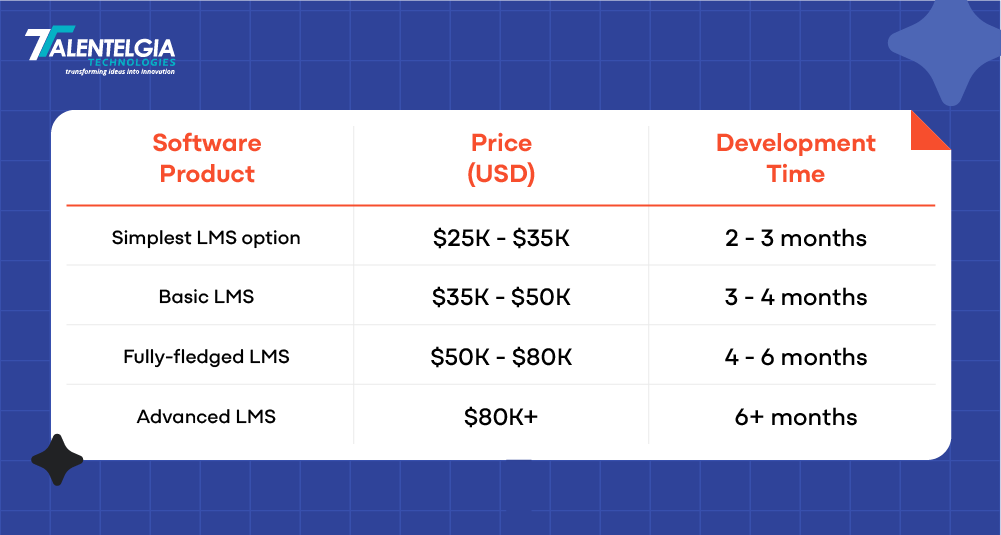
Other considerations include maintenance services, routine updates, and initial cloud hosting. For more accurate pricing, it is advisable to consult our sales team at Talentelgia concerning your specific needs.
Conclusion
With the increasing cost of training and the ineffectiveness of the existing traditional learning systems, global organizations need to look for a transformative solution. Enterprise LMS platforms have become paramount for businesses in training process automation, cost management, and result improvement. Adopting the best enterprise LMS is not to be taken lightly. Carefully consider your business's pain points and issues, research relevant tools in the market, and see if they fulfill your requirements.
Want to see how an enterprise platform can actually change the game? Schedule a call with us!


 Healthcare App Development Services
Healthcare App Development Services
 Real Estate Web Development Services
Real Estate Web Development Services
 E-Commerce App Development Services
E-Commerce App Development Services E-Commerce Web Development Services
E-Commerce Web Development Services Blockchain E-commerce Development Company
Blockchain E-commerce Development Company
 Fintech App Development Services
Fintech App Development Services Fintech Web Development
Fintech Web Development Blockchain Fintech Development Company
Blockchain Fintech Development Company
 E-Learning App Development Services
E-Learning App Development Services
 Restaurant App Development Company
Restaurant App Development Company
 Mobile Game Development Company
Mobile Game Development Company
 Travel App Development Company
Travel App Development Company
 Automotive Web Design
Automotive Web Design
 AI Traffic Management System
AI Traffic Management System
 AI Inventory Management Software
AI Inventory Management Software
 AI Software Development
AI Software Development  AI Development Company
AI Development Company  AI App Development Services
AI App Development Services  ChatGPT integration services
ChatGPT integration services  AI Integration Services
AI Integration Services  Generative AI Development Services
Generative AI Development Services  Natural Language Processing Company
Natural Language Processing Company Machine Learning Development
Machine Learning Development  Machine learning consulting services
Machine learning consulting services  Blockchain Development
Blockchain Development  Blockchain Software Development
Blockchain Software Development  Smart Contract Development Company
Smart Contract Development Company  NFT Marketplace Development Services
NFT Marketplace Development Services  Asset Tokenization Company
Asset Tokenization Company DeFi Wallet Development Company
DeFi Wallet Development Company Mobile App Development
Mobile App Development  IOS App Development
IOS App Development  Android App Development
Android App Development  Cross-Platform App Development
Cross-Platform App Development  Augmented Reality (AR) App Development
Augmented Reality (AR) App Development  Virtual Reality (VR) App Development
Virtual Reality (VR) App Development  Web App Development
Web App Development  SaaS App Development
SaaS App Development Flutter
Flutter  React Native
React Native  Swift (IOS)
Swift (IOS)  Kotlin (Android)
Kotlin (Android)  Mean Stack Development
Mean Stack Development  AngularJS Development
AngularJS Development  MongoDB Development
MongoDB Development  Nodejs Development
Nodejs Development  Database Development
Database Development Ruby on Rails Development
Ruby on Rails Development Expressjs Development
Expressjs Development  Full Stack Development
Full Stack Development  Web Development Services
Web Development Services  Laravel Development
Laravel Development  LAMP Development
LAMP Development  Custom PHP Development
Custom PHP Development  .Net Development
.Net Development  User Experience Design Services
User Experience Design Services  User Interface Design Services
User Interface Design Services  Automated Testing
Automated Testing  Manual Testing
Manual Testing  Digital Marketing Services
Digital Marketing Services 
 Ride-Sharing And Taxi Services
Ride-Sharing And Taxi Services Food Delivery Services
Food Delivery Services Grocery Delivery Services
Grocery Delivery Services Transportation And Logistics
Transportation And Logistics Car Wash App
Car Wash App Home Services App
Home Services App ERP Development Services
ERP Development Services CMS Development Services
CMS Development Services LMS Development
LMS Development CRM Development
CRM Development DevOps Development Services
DevOps Development Services AI Business Solutions
AI Business Solutions AI Cloud Solutions
AI Cloud Solutions AI Chatbot Development
AI Chatbot Development API Development
API Development Blockchain Product Development
Blockchain Product Development Cryptocurrency Wallet Development
Cryptocurrency Wallet Development About Talentelgia
About Talentelgia  Our Team
Our Team  Our Culture
Our Culture 
 Healthcare App Development Services
Healthcare App Development Services Real Estate Web Development Services
Real Estate Web Development Services E-Commerce App Development Services
E-Commerce App Development Services E-Commerce Web Development Services
E-Commerce Web Development Services Blockchain E-commerce
Development Company
Blockchain E-commerce
Development Company Fintech App Development Services
Fintech App Development Services Finance Web Development
Finance Web Development Blockchain Fintech
Development Company
Blockchain Fintech
Development Company E-Learning App Development Services
E-Learning App Development Services Restaurant App Development Company
Restaurant App Development Company Mobile Game Development Company
Mobile Game Development Company Travel App Development Company
Travel App Development Company Automotive Web Design
Automotive Web Design AI Traffic Management System
AI Traffic Management System AI Inventory Management Software
AI Inventory Management Software AI Software Development
AI Software Development AI Development Company
AI Development Company ChatGPT integration services
ChatGPT integration services AI Integration Services
AI Integration Services Machine Learning Development
Machine Learning Development Machine learning consulting services
Machine learning consulting services Blockchain Development
Blockchain Development Blockchain Software Development
Blockchain Software Development Smart contract development company
Smart contract development company NFT marketplace development services
NFT marketplace development services IOS App Development
IOS App Development Android App Development
Android App Development Cross-Platform App Development
Cross-Platform App Development Augmented Reality (AR) App
Development
Augmented Reality (AR) App
Development Virtual Reality (VR) App Development
Virtual Reality (VR) App Development Web App Development
Web App Development Flutter
Flutter React
Native
React
Native Swift
(IOS)
Swift
(IOS) Kotlin (Android)
Kotlin (Android) MEAN Stack Development
MEAN Stack Development AngularJS Development
AngularJS Development MongoDB Development
MongoDB Development Nodejs Development
Nodejs Development Database development services
Database development services Ruby on Rails Development services
Ruby on Rails Development services Expressjs Development
Expressjs Development Full Stack Development
Full Stack Development Web Development Services
Web Development Services Laravel Development
Laravel Development LAMP
Development
LAMP
Development Custom PHP Development
Custom PHP Development User Experience Design Services
User Experience Design Services User Interface Design Services
User Interface Design Services Automated Testing
Automated Testing Manual
Testing
Manual
Testing About Talentelgia
About Talentelgia Our Team
Our Team Our Culture
Our Culture
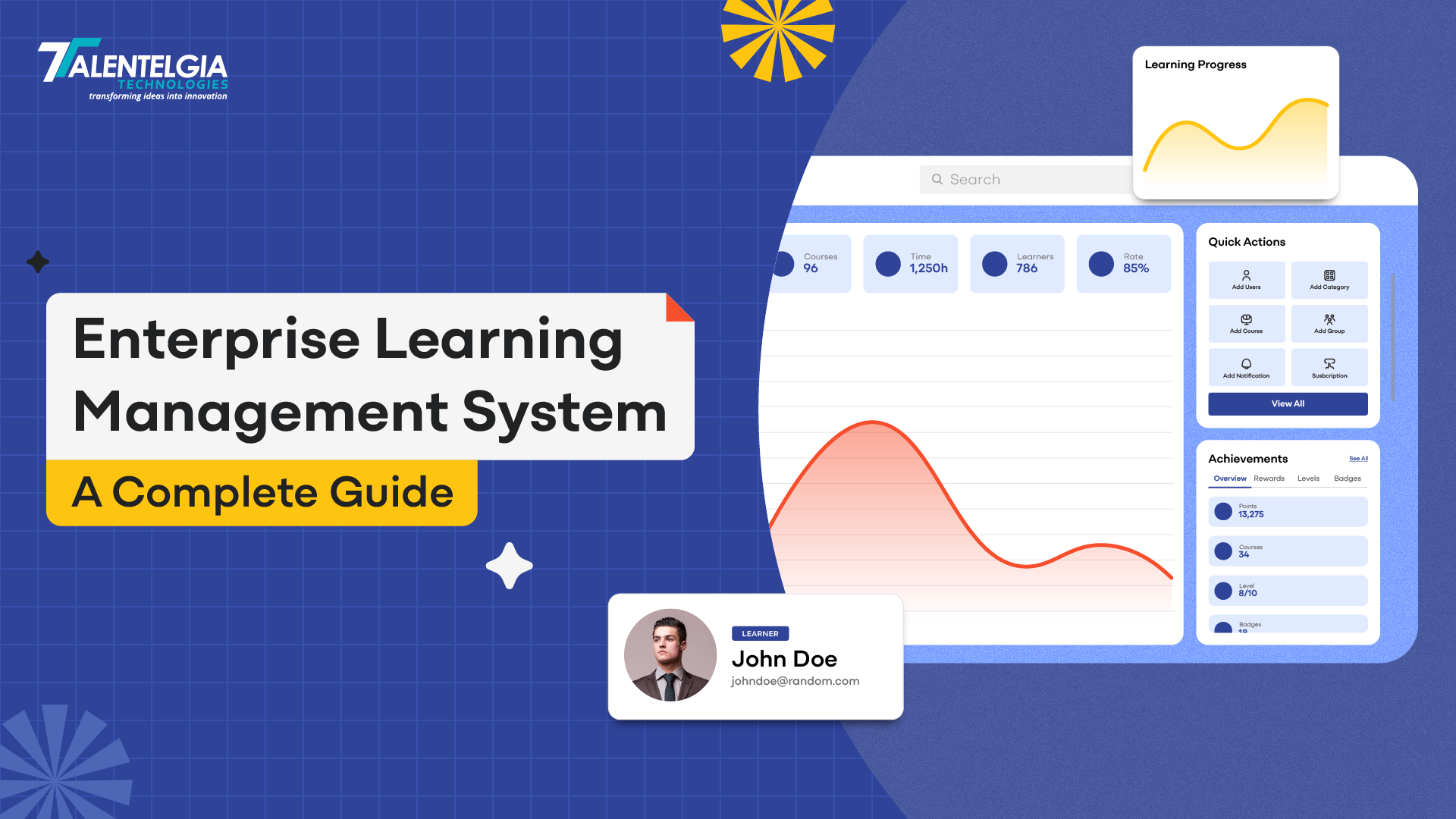

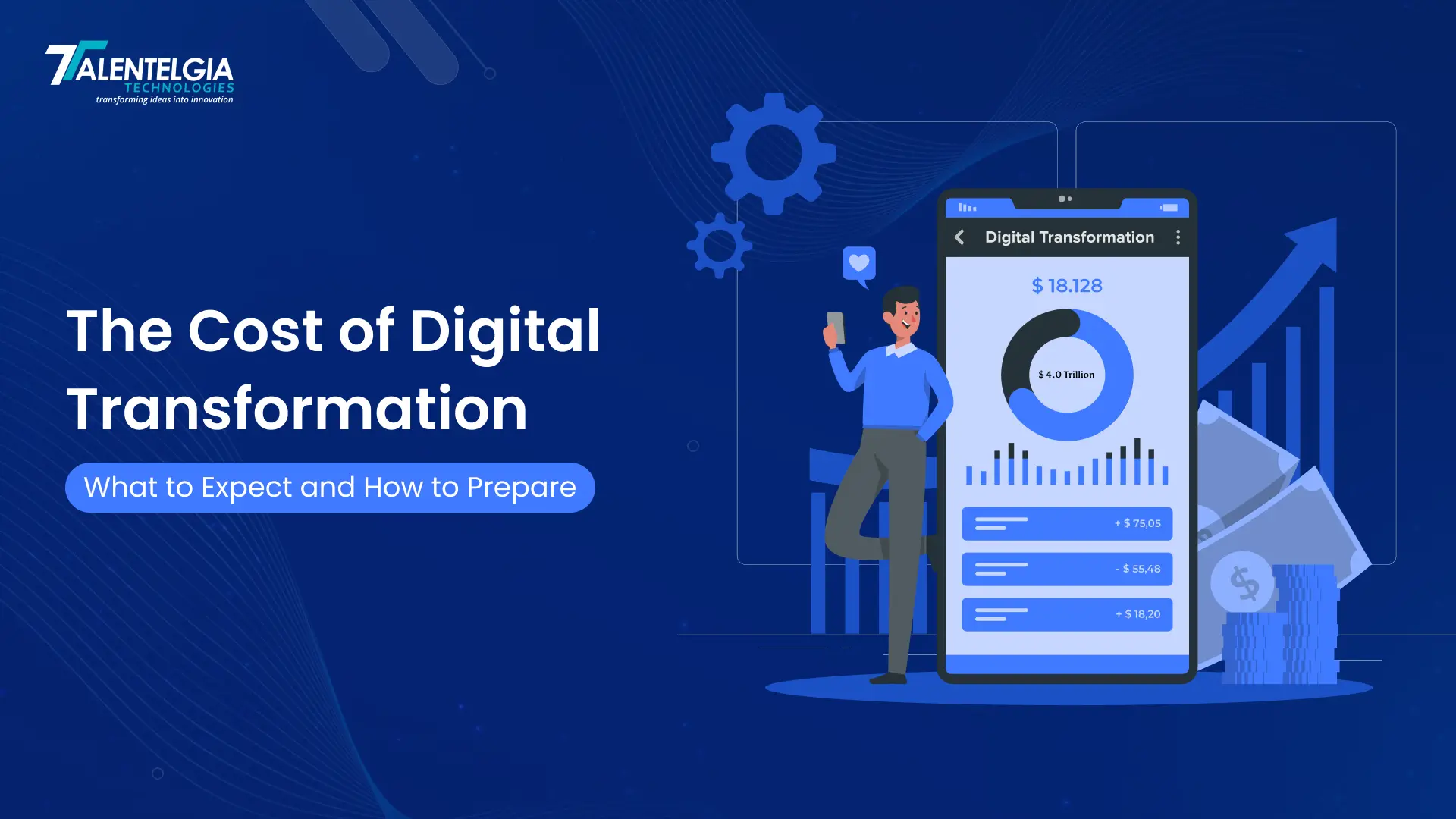

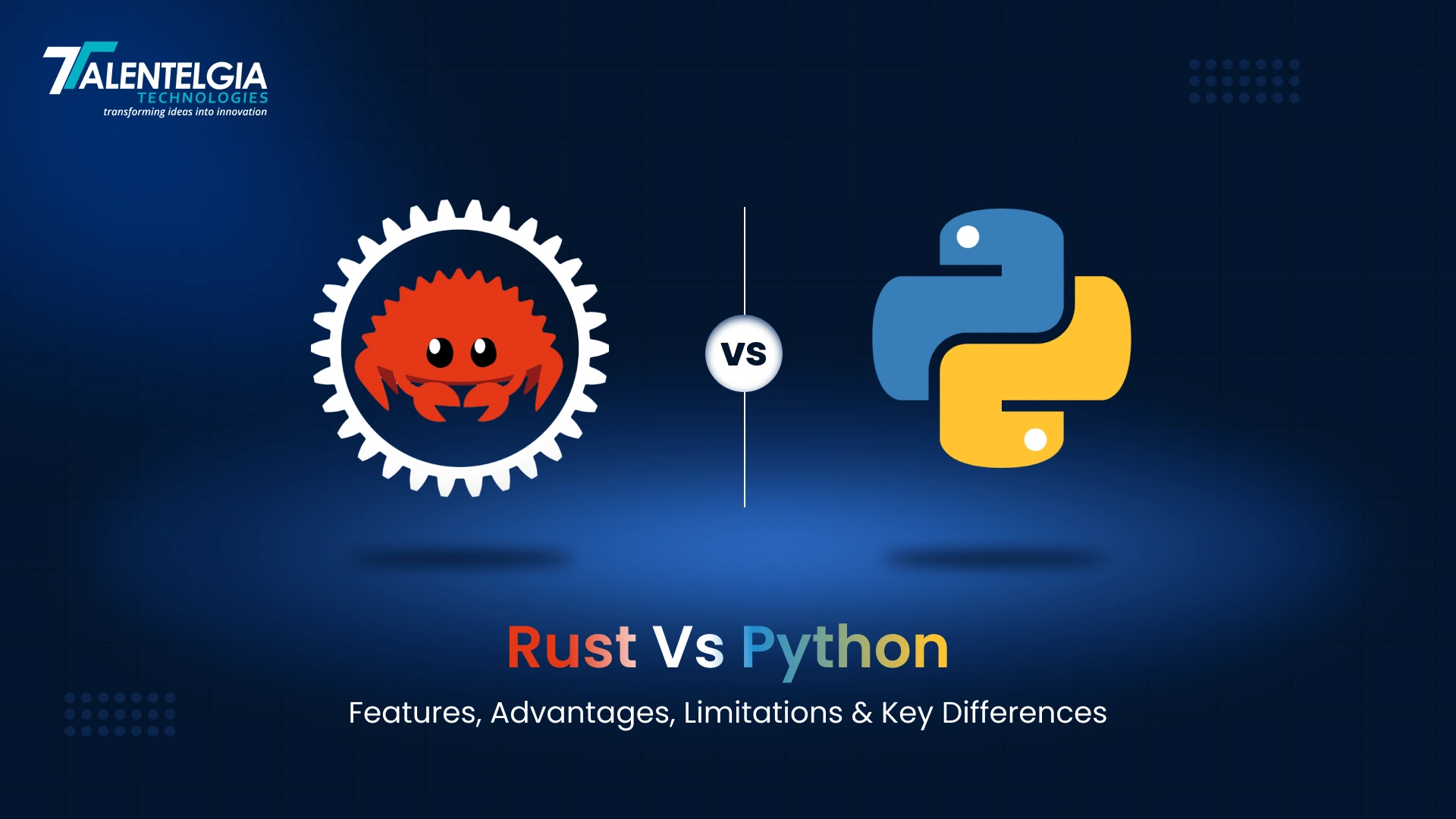











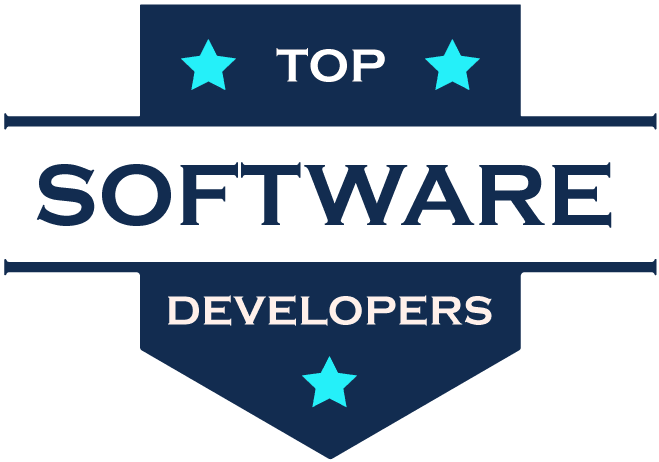
 Write us on:
Write us on:  Business queries:
Business queries:  HR:
HR: 




